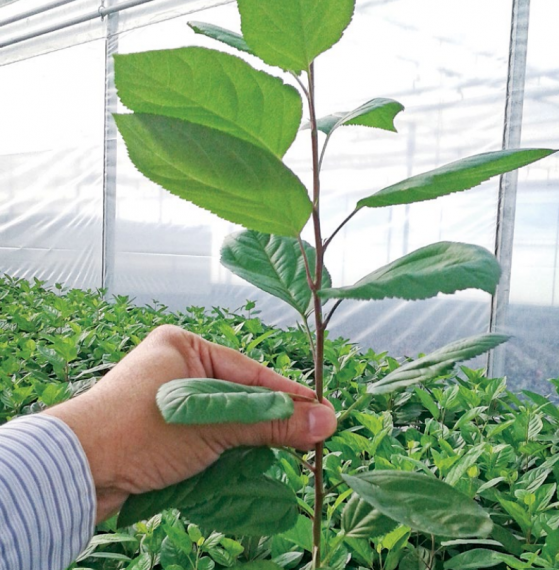Big plans for micropropagation

Efforts to replace agriculture and food imports with homegrown products are arising in even the most specialized market segments, such as micropropagated trees.
Micropropagation uses small parts of plants instead of stem or root cuttings, allowing more trees to be grown faster. This innovation is important—demand for apple root stocks and varieties is predicted to reach more than two million plants per year for at least the next decade.
Currently, most micropropagated trees come to Canada from Europe or the United States. Unfortunately for producers here, inconsistent delivery, poor plant quality, loss during transportation and currency fluctuation are regular frustrations.
University of Guelph plant agriculture professor Praveen Saxena thinks there’s a better way. Working with the Gryphon’s LAAIR (Leading to the Accelerated Adoption of Innovative Research) program, he and research associate Mukund Shukla at the Gosling Research Institute for Plant Preservation have developed an efficient commercial-scale technology for micropropagating apple trees.
This technology includes a unique nutrient medium, container and bioreactor-based culture system—that is, a manufactured device that supports a biologically active environment in which plant cells or tissues can thrive. The conventional technology for micropropagating plants hasn’t changed much. Traditional containers and bioreactors are universal and not optimized for specific plant species and can handle only a few growing conditions.
That’s where Saxena’s bioreactor comes in. It provides optimum growth conditions with increased control over parameters, such as temperature, light and availability of nutrient medium, which increase growth and numbers of the apple saplings.
He says that, ultimately, this technology will allow Ontario growers to meet apple tree demand and expand apple production. And it’s very economical: he says trees can be multiplied at half or even one-third of the cost of traditional methods depending on the variety.
The process starts with a small growing bud on a source plant. The bud tissue goes into the bioreactor, where it develops a small shoot, which multiplies to generate many more. Once these new shoots develop further, roots begin to grow, and the plant is ready to be planted in soil in a greenhouse or in the field until it is large enough to be sold as a tree. For an apple tree, this process can take 14-18 months.
Micropropagation technology also offers employment opportunities for students who wish to pursue a horticulture career, says Shukla. “Increasing Ontario’s micropropagation industry will provide apple trees faster to growers, and open more positions as research assistants, lab assistants and interns,” he says.
Shukla and Saxena have created a new micropropagation device called Plant Tissue Culture Plus (PTC+) to propagate a wide range of trees, ornamental and medicinal plants. Another priority for micropropagation is hazelnut trees—they’re in high demand from candy manufacturer Ferrero Canada, which is trying to develop a vibrant hazelnut industry in Ontario. And like apple growers, Ferrero Canada can’t get a reliable supply of micropropagated trees elsewhere.
This research is funded by the Ontario Agri-Food Innovation Alliance through the Gryphon’s LAAIR program. Additional funding was provided by the Natural Sciences and Engineering Research Council and Ontario Centres of Excellence.
Articles in Research magazine are written and produced in part by participants in the Students Promoting Awareness of Research Knowledge (SPARK). See more stories from the 2019 Agri-Food Yearbook (PDF).